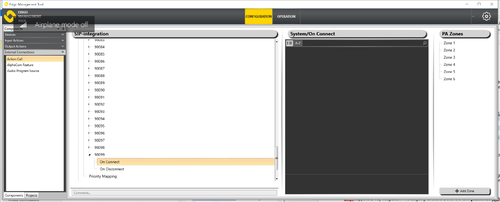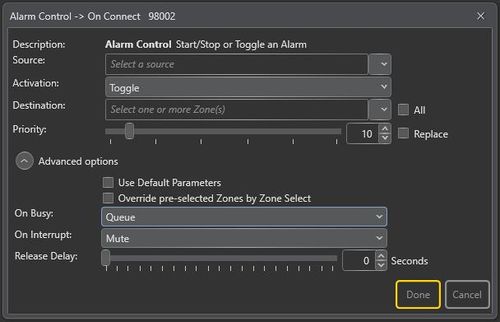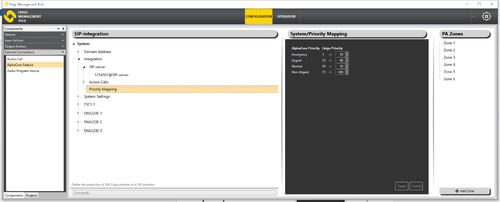SIP integration
This article describes how the Exigo system can be integrated with 3rd party SIP servers via SIP trunking, and the features achieved via such an interface.
Prereqesites
Exigo SIP integration requires the following:
- An Exigo system in single or A+B-mode (hot standby) running SW v1.3.x.x
- Exigo Management Tool v1.3.x.x
- An iPBX or SIP device supporting SIP over UDP
Changes to SIP configuration require a reboot of the Exigo System Controller.
System overview
An EXIGO system is integrated to a SIP-server over the LAN.
Network requirements
Protocols
Exigo supports the following protocols for integration:
Function Protocol Ports ------------- -------- ----------- SIP Signaling UDP 5060 RTP Audio UDP 61000:61150 SNMP v1/v2c UDP 161
Ports
The following ports must be open in firewall for proper SIP integration
- 5060
- 61000 to 61150
- 161 (for SNMP, optional)
Audio Codecs
Incoming (from SIP server)
Exigo offers transcoding of the following codecs for incoming audio streams. However the native codec is G.722, and this can be passed through without any transcoding delay and is therefore highly recommended.
Codec Audiobandwidth Data bandwidth ----------- -------------- -------------- G.722 7.0 kHz 64 kb/s G.711 A-law 3.5 kHz 64 kb/s G.711 µ-law 3.5 kHz 64 kb/s G.729 3.5 kHz 8 kb/s
Outgoing (from Exigo)
All Exigo internal audio is wideband, and coded in G.722. The SIP server and device must support G.722 for outgoing integration (Exigo activity is sent to external SIP system).
Functionality
Action calls (incoming activity)
Exigo supports up to 99 actions calls that can be triggered by external SIP devices through the SIP trunk. These occupy the range of 98001 to 98099 and are configured in Exigo Management Tool. All action calls have an ON CONNECT and ON DISCONNECT action parameter.
On Connect
This activity is triggered as a SIP connection to the specified action call is made.
On Disconnect
This activity is triggered as an active SIP connection to the specified action call is taken down.
Action call functions
Any Exigo function can be allocated to an Action Call, but some will not have any practical function.
The following functions in Exigo are suitable for use with Action Call:
Input Action Description ------------ -------------------------------------- Alarm Control Start or stop alarms in selected zones Audio Program Control Start or stop audio from program sources Clear Activity Stop all activites of a given type or in (a) given zone(s) Live Speech Distribute audio to one or more zones Local Mute Control Activate local muting (timer or manual) Message Control Start or stop locally stored messages
Priority (incoming)
Actions with higher priority will replace the previous activity. Exigo offers several modes for addressing conflicts:
Higher priority call into a busy zone
- Mute – the activity is muted during the high-pri activity and resumed after
- Cancel – the previous activity is canceled
Lower priority call into a busy zone
- Reject – Cancel the entire activity
- Go Partial – transmit to all selected zones except busy ones
- Queue – Assume activity when all selected zones are free
Same priority call into a busy zone
- First-come-first-served – standard Exigo behavior
- Replace – only if “replace” flag is set (next to priority slider)
If desired, one action can be configured to two different Action Call numbers, one with a higher priority than the other. In the SIP server, limiting access to the two numbers can be used to differentiate high-priority devices from low-priority devices.
SIP Header
See this article.
SIP Device (outgoing)
Exigo supports 2-way integration. The outgoing functions are on the form [subscriber]@[ip-address]. In this form, [subscriber] must be comprised of numbers (0-9) only.
SIP Device
The SIP Device simply lets one add a “virtual” device to a given Zone so that a particular activity can set up a SIP call to an external device.
This can be used to:
- Trigger a function in the iPBX – event handled by iPBX
- Transmit audio activity out of the Exigo system (for integration of SIP-telephones or recording devices)
Priority (outgoing)
Exigo offers 100 levels of priority. For compatibility Exigo translates these to the 4 priority levels offered in RFC3261 (SIP).
Availability
This function is available from Exigo 1.3 and newer.




